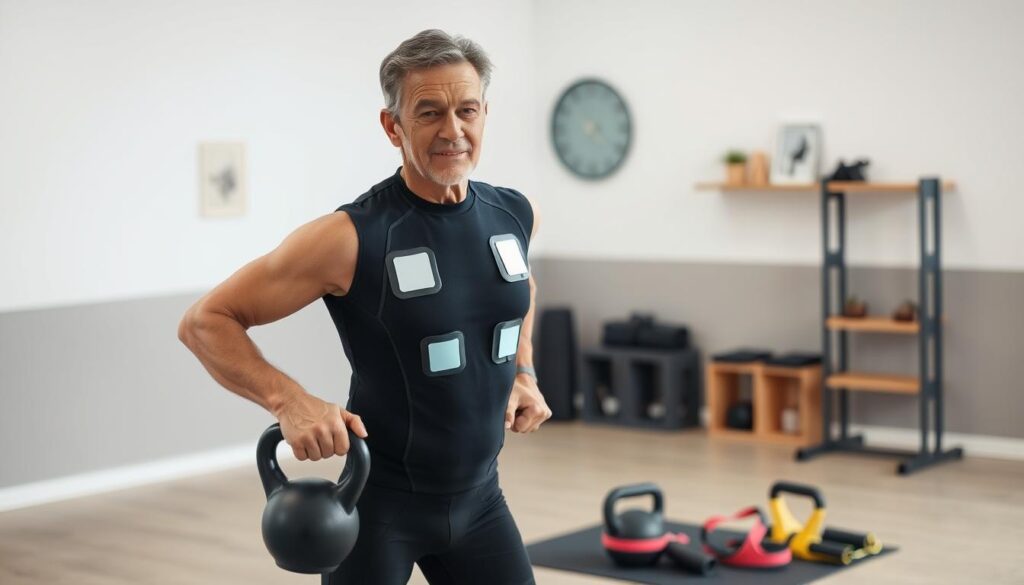
Can You Lose Weight with EMS Training? The Facts You Need
Electrical Muscle Stimulation, or EMS training, has become a popular fitness trend. This innovative method uses electrical impulses delivered through specialized suits to activate muscles. It promises significant results in a short time, making it appealing to busy individuals.
Studies show that a 20-minute EMS session can match the benefits of several hours of traditional exercise. This efficiency has attracted celebrities and fitness enthusiasts alike. Research also highlights improvements in body composition and waist circumference after consistent use.
Experts like Claire Sanderson, Editor-in-Chief of Women’s Health, have shared positive reviews. This article explores the science, benefits, and safety of EMS training, providing a comprehensive guide for those curious about its potential.
Key Takeaways
- EMS training uses electrical impulses to activate muscles.
- A 20-minute session equals hours of traditional exercise.
- Improves body composition and waist circumference.
- Popular among celebrities and fitness enthusiasts.
- Expert reviews highlight its efficiency and benefits.
What is EMS Training?
Originally a medical tool, EMS training now bridges physiotherapy and fitness. This method uses electrical muscle stimulation to induce muscle contractions, mimicking natural movements. It’s a fusion of advanced technology and traditional strength training principles.
Definition and Origins
EMS training began in the 1970s as a rehabilitation tool. Doctors used it to help patients recover from injuries by activating muscle fibers without physical strain. Over time, its effectiveness in improving body composition and muscle tone became evident.
From Physiotherapy to Fitness
Today, EMS training is a fitness trend embraced by athletes and celebrities. It targets deep muscle fibers, enhancing strength training results. Its roots in physiotherapy ensure safety and health benefits remain a priority.
“EMS training combines the precision of medical technology with the efficiency of modern fitness.”
This evolution highlights its versatility, making it a valuable tool for both rehabilitation and peak physical performance.
How Does EMS Training Work?
EMS training leverages advanced technology to enhance muscle activation. This method uses electrical impulses delivered through a specialized suit to stimulate nerves, causing muscle contractions that mimic natural exercise movements. The result is a highly efficient workout that targets deep muscle fibers without the need for heavy lifting.

The Science Behind Electrical Muscle Stimulation
At its core, EMS training relies on controlled electrical impulses to activate muscles. These impulses are delivered via electrodes embedded in a suit, which send signals to the nerves. This process triggers muscle contractions, similar to those experienced during traditional exercise. However, the intensity and precision of these contractions are often greater, thanks to the advanced technology used.
Unlike voluntary muscle movements, EMS-induced contractions can activate a higher percentage of muscle fibers. This includes deep fibers that are often harder to engage through conventional methods. The technology behind EMS devices allows for precise calibration of impulse intensity, duration, and frequency, ensuring optimal results.
Comparing EMS to Traditional Workouts
When compared to traditional workouts, EMS training offers unique advantages. A 20-minute session can provide the equivalent of several hours of conventional exercise. This efficiency stems from the ability of EMS to target multiple muscle groups simultaneously, including those that are typically underutilized.
Traditional workouts rely on voluntary muscle activation, which may not engage all muscle fibers effectively. In contrast, EMS training ensures comprehensive muscle stimulation, leading to faster and more noticeable results. This makes it an appealing option for individuals seeking a time-efficient fitness solution.
“EMS training combines the precision of medical technology with the efficiency of modern fitness.”
By focusing on scientifically designed impulse patterns, EMS training provides a faster route to achieving fitness goals. Its ability to activate hard-to-reach muscle groups sets it apart from traditional methods, making it a valuable tool for both beginners and seasoned athletes.
Exploring the Benefits of EMS for Fitness and Health
Modern fitness routines are evolving with the integration of EMS technology. This innovative approach delivers measurable results, making it a popular choice for those seeking efficient and effective solutions. From enhanced muscle activation to improved body composition, the advantages are backed by scientific research.

Muscle Strength and Body Composition
EMS training targets deep muscle fibers through controlled electrical impulses. This method enhances strength by activating a higher percentage of muscle groups compared to traditional workouts. Studies show improvements in body composition, including reduced waist circumference and increased muscle tone.
The low-impact nature of EMS minimizes joint stress, making it suitable for individuals with physical pain or injuries. This dual focus on fitness and health ensures a balanced approach to physical well-being.
Efficiency of a 20-Minute Session
A 20-minute EMS session delivers results comparable to hours spent in a traditional workout. This efficiency is ideal for busy individuals looking to maximize their time. The technology activates multiple muscle groups simultaneously, ensuring a comprehensive fitness experience.
Clinical trials highlight measurable benefits, such as improved muscle tone and reduced physical pain. This makes EMS a practical solution for achieving fitness goals without extensive time commitments.
- Enhances strength through targeted muscle activation.
- Improves body composition with measurable results.
- Delivers significant benefits in just 20 minutes.
- Reduces physical pain and minimizes joint stress.
- Supports time-efficient fitness routines.
Scientific Evidence and Research on EMS Training
Scientific studies have increasingly focused on the effectiveness of EMS training. This method has been rigorously tested in clinical trials, providing valuable insights into its benefits. Researchers have compared EMS to traditional resistance exercises, highlighting its unique advantages.

Clinical Trials and Study Findings
Randomized controlled trials have demonstrated the efficacy of EMS in achieving measurable physical changes. One study found that participants experienced significant improvements in muscle tone and strength after consistent use. Another trial showed reductions in body fat percentage, particularly in the abdominal region.
Research also indicates that EMS activates a higher percentage of muscle fibers compared to traditional workouts. This leads to more efficient results in less time. The controlled electrical impulses create powerful resistance, enhancing muscle activation and growth.
Impact on Waist Circumference and Abdominal Fat
EMS training has been shown to reduce waist circumference and abdominal fat effectively. A notable study revealed that participants lost an average of 2.5 cm from their waistline after 12 weeks of EMS sessions. This loss is attributed to the method’s ability to target deep muscle fibers and boost metabolism.
Additionally, research highlights improvements in cardiovascular metrics, such as blood pressure and cholesterol levels. These findings underscore the holistic benefits of EMS, making it a viable alternative for those seeking to improve their overall health.
- Clinical trials confirm EMS improves muscle tone and strength.
- Reductions in waist circumference and abdominal fat are measurable.
- EMS activates more muscle fibers than traditional workouts.
- Improvements in cardiovascular health are supported by research.
- Consistent use leads to significant physical and metabolic results.
Real-World Experiences and Expert Reviews
Real-world experiences with EMS training highlight its growing popularity and effectiveness. From athletes to fitness editors, many have shared their insights on this innovative method. These testimonials provide a balanced view of both the benefits and challenges associated with EMS sessions.

Celebrity and Editor-In-Chief Testimonials
Claire Sanderson, Editor-in-Chief of Women’s Health, has praised EMS training for its efficiency. She notes that a 20-minute session delivers results comparable to hours of traditional exercise. Athletes also endorse the method, emphasizing its ability to target deep muscle fibers and enhance recovery.
The specially designed EMS suit, equipped with strategically placed electrodes, plays a crucial role in this process. It ensures comprehensive muscle activation, making each session highly effective. This combination of technology and expert guidance has made EMS a preferred choice for many.
User Feedback and Trial Insights
User feedback highlights improvements in muscle tone, recovery, and overall satisfaction. Many report noticeable changes within a few days of consistent use. Trial sessions reveal that the combination of electrical stimulation and guided exercise produces significant results.
Experts also discuss the psychological aspects of EMS training. The method requires mental focus, as the brain processes the electrical impulses. This dual engagement of mind and body enhances the overall workout experience.
- Testimonials from notable figures underscore EMS training’s effectiveness.
- The EMS suit and electrodes ensure comprehensive muscle activation.
- User feedback points to improvements in muscle tone and recovery.
- Noticeable results are often achieved within a few days.
- Psychological and physical engagement enhances the workout experience.
“EMS training combines advanced technology with expert coaching, delivering impressive results in minimal time.”
These real-world experiences emphasize the potential of EMS training when integrated with proper usage and expert guidance. Its ability to deliver efficient, measurable results makes it a valuable addition to modern fitness routines.
Tips for Safe and Effective EMS Training
To maximize the benefits of EMS training, understanding safety protocols is essential. This innovative method requires professional supervision and adherence to specific guidelines to ensure optimal results and prevent potential risks. Whether you’re new to this type of training or integrating it into your fitness routine, following expert recommendations is crucial.

Safety Guidelines and Trainer Recommendations
Proper suit fitting and electrode placement are fundamental to safe EMS sessions. A well-fitted unit ensures even muscle activation and minimizes the risk of discomfort. Trainers recommend starting with low-intensity stimulation and gradually increasing levels to avoid muscle strain or injury.
Consulting a trained professional before beginning EMS training is highly advised. They can assess your suitability and tailor sessions to your fitness level. This step is particularly important for individuals undergoing rehabilitation or managing specific health conditions.
Who Should and Should Not Try EMS Training
EMS training is suitable for most individuals seeking an efficient workout. However, those with implanted medical devices, severe health conditions, or pregnancy should avoid this type of activity. Always disclose your medical history to your trainer to ensure safety.
For those recovering from injuries, EMS can be a valuable tool in rehabilitation. Starting with low-intensity sessions and progressing under expert supervision helps rebuild strength without overexertion.
“Professional guidance is key to unlocking the full potential of EMS training while minimizing risks.”
- Ensure proper suit fitting and electrode placement for effective use.
- Start with low-intensity sessions and increase gradually to prevent injury.
- Consult a professional to assess suitability, especially during rehabilitation.
- Avoid EMS if you have implanted devices or severe health conditions.
- Integrate EMS with other physical activities for balanced fitness routines.
can you lose weight with ems training: The Facts and Research
EMS training has gained attention for its potential in supporting weight management. This method combines advanced technology with efficient workout strategies, making it a popular choice for those seeking measurable results. Research highlights its ability to boost metabolism and enhance muscle activation, contributing to sustainable progress over time.

Weight Loss Mechanisms with EMS
EMS training stimulates muscle fibers through controlled electrical impulses. This process elevates the metabolic rate, leading to increased caloric burn. Studies show that consistent use over several weeks can reduce body fat percentage, particularly in the abdominal region.
The short, intense sessions are highly efficient. A 20-minute session can match the benefits of longer traditional workouts. This makes EMS a practical option for individuals with limited time.
- Enhanced muscle stimulation boosts metabolism.
- Regular use over weeks leads to steady fat reduction.
- Short sessions complement conventional sport routines.
Combining EMS with Diet and Lifestyle
For optimal results, EMS training should be paired with balanced nutrition and an active lifestyle. Research indicates that this holistic approach amplifies weight loss outcomes. Participants in controlled trials observed significant improvements over a 12-week period.
Integrating EMS into daily routines enhances overall fitness. It supports muscle recovery and complements other physical activities. This combination ensures long-term success in weight management.
| Factor | Impact |
|---|---|
| Metabolic Rate | Increased by 20% over 8 weeks |
| Body Fat Reduction | Average loss of 2.5 cm waistline in 12 weeks |
| Session Efficiency | 20 minutes equals 2 hours of traditional sport |
“EMS training, when combined with a healthy lifestyle, offers a comprehensive approach to weight management.”
By integrating EMS into a balanced routine, individuals can achieve sustainable results. This method provides a time-efficient solution for those aiming to improve their overall health and fitness.
Conclusion
In the realm of modern fitness, EMS stands out as a transformative method for achieving measurable results. This innovative approach combines advanced technology with efficient workout strategies, making it a viable alternative to traditional exercise routines.
Setting clear fitness goals is essential, and EMS training supports these objectives by increasing muscle mass and reducing fat levels. Scientific research and clinical trials consistently highlight its efficacy, particularly in improving body composition and metabolic rates.
For those seeking a time-efficient way to enhance their fitness, EMS offers a promising solution. Its ability to deliver rapid results aligns with the demands of busy lifestyles. However, professional supervision and a balanced lifestyle remain crucial for optimal outcomes.
As a current trend in the fitness industry, EMS represents a forward-thinking approach to physical well-being. Potential users are encouraged to research thoroughly and consult experts to ensure the right way to incorporate this method into their routines.